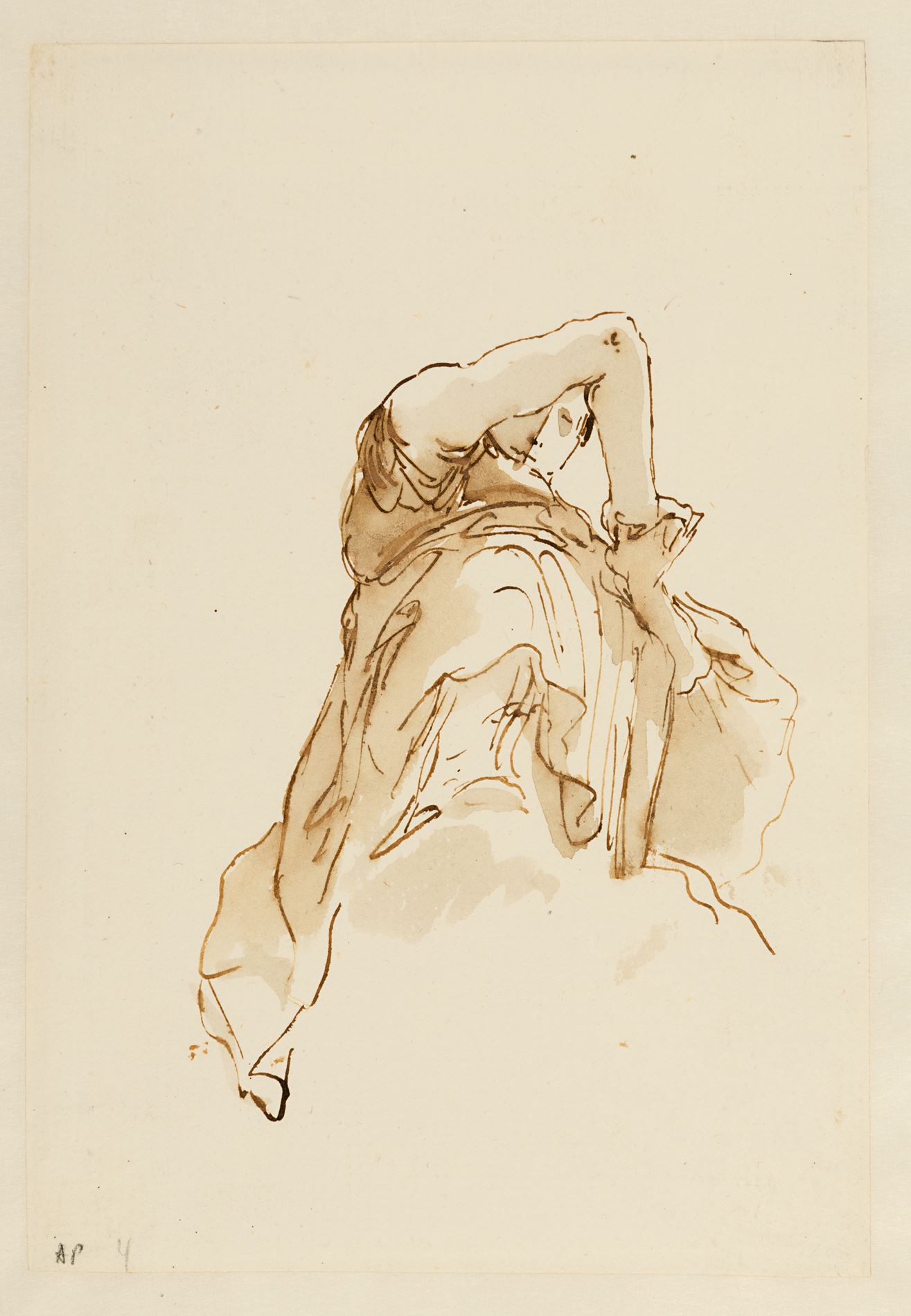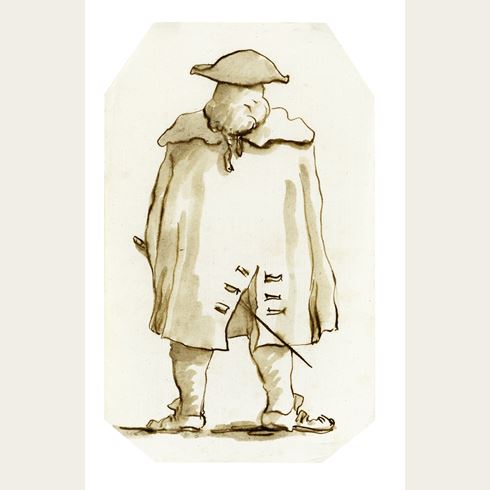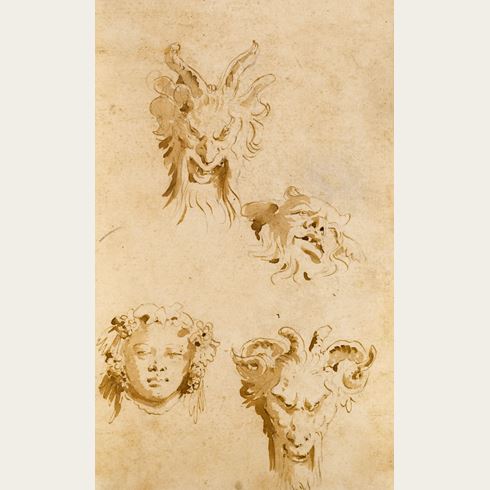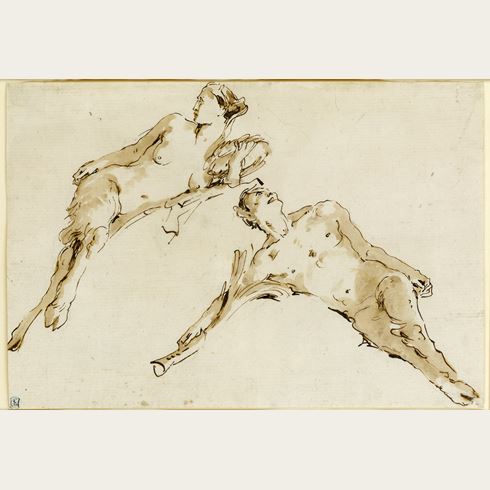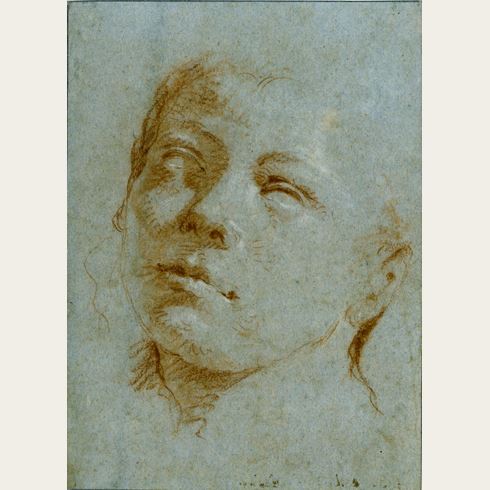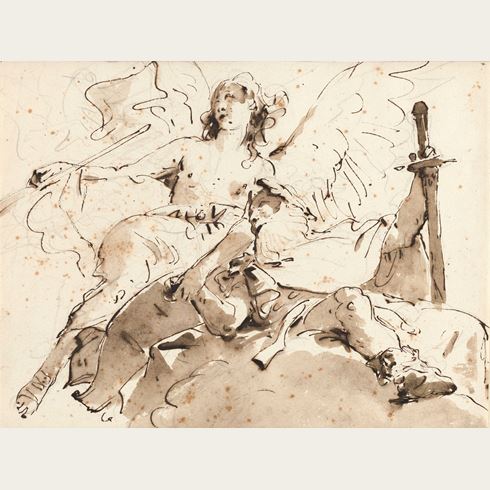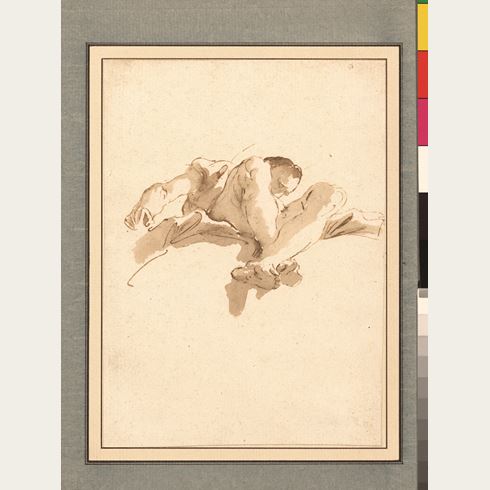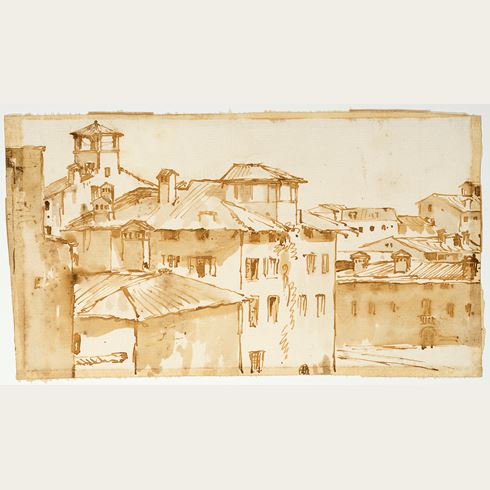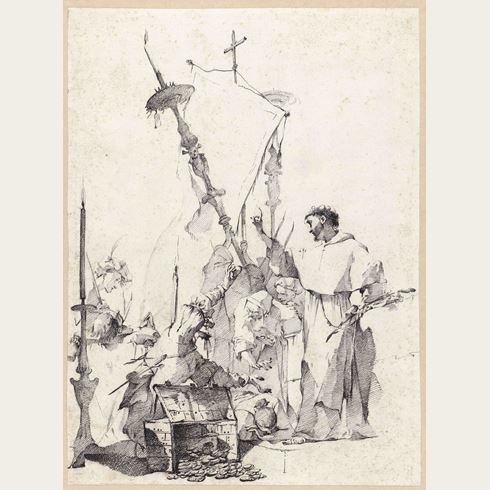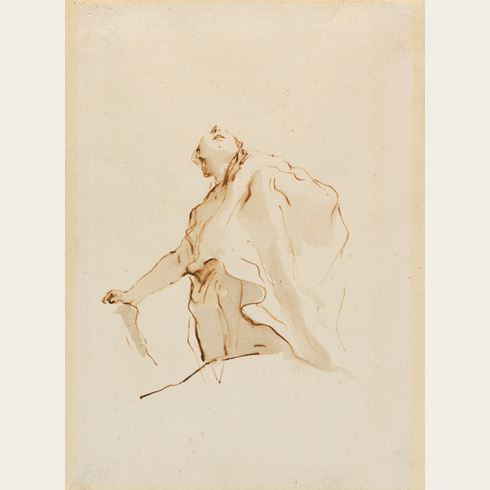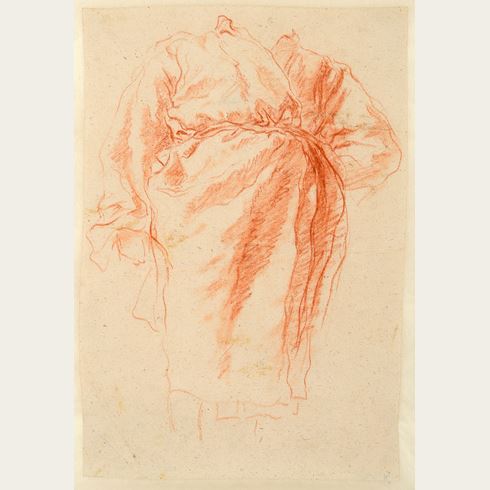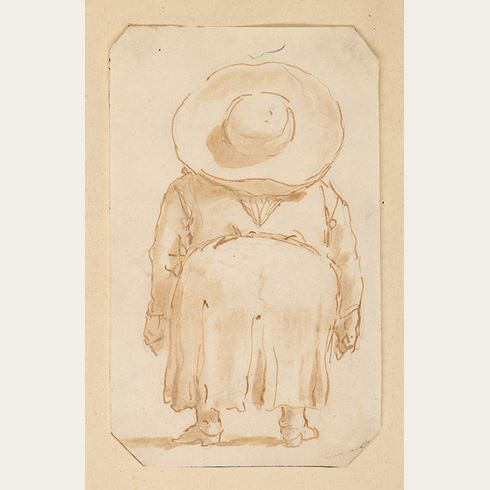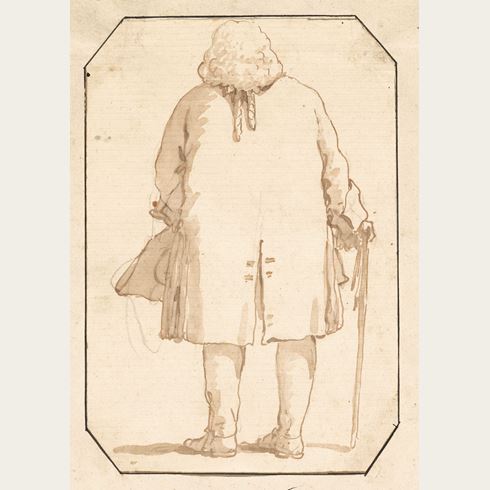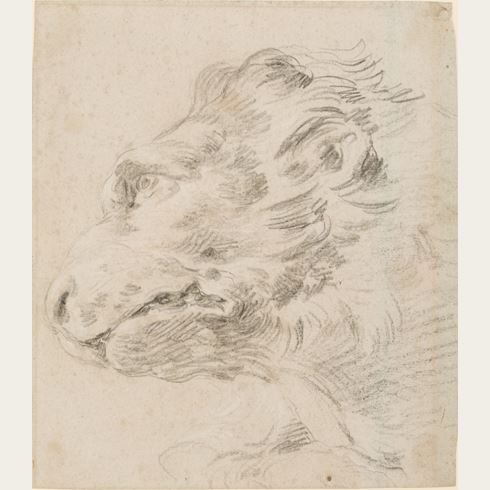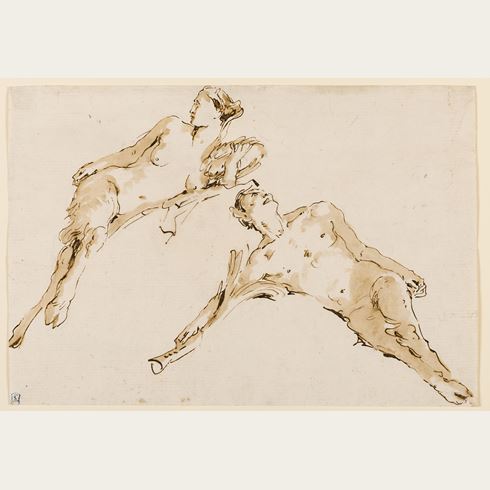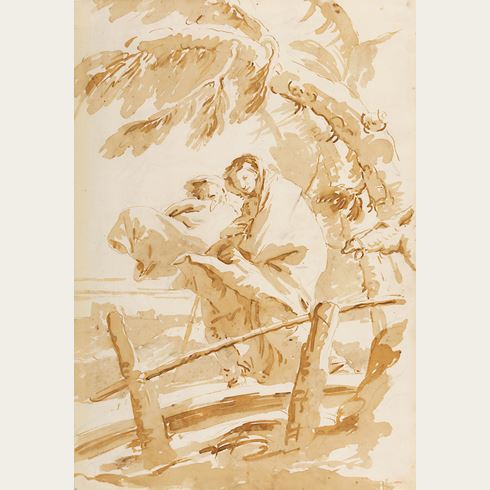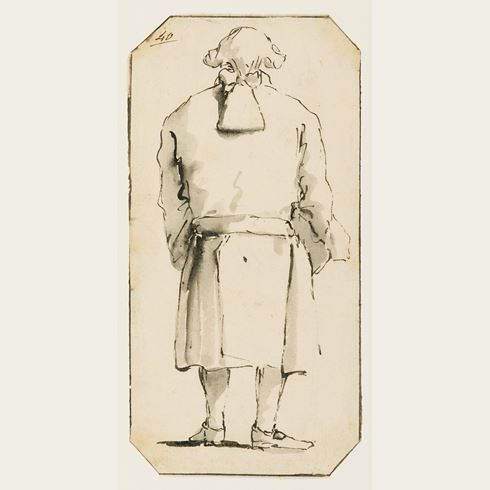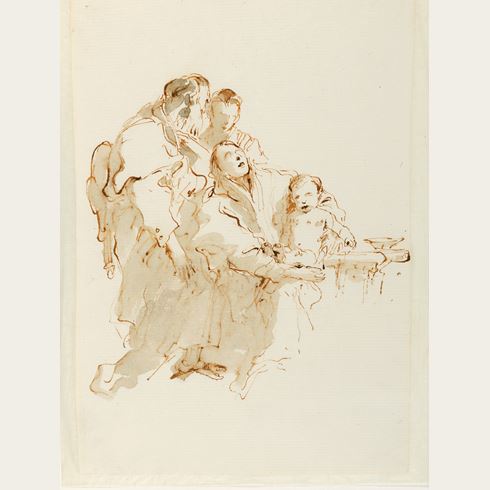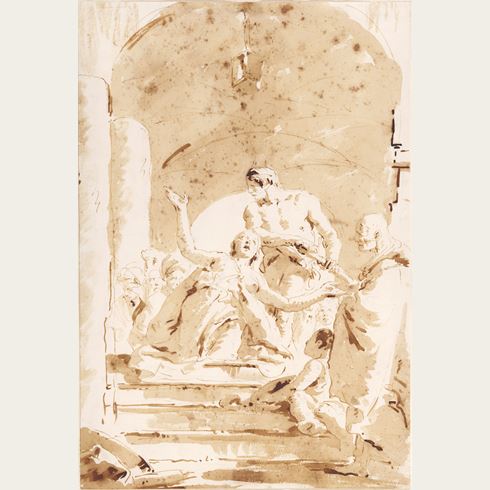Giovanni Battista TIEPOLO
(Venice 1696 - Madrid 1770)
A Study for a Ceiling: A Standing Draped Figure, Seen from Below
205 x 141 mm. (8 1/8 x 5 1/2 in.)
This fine sheet, never previously exhibited, is one of a large group of virtuoso studies by Tiepolo of figures in clouds viewed from below, which seem to have been done as compositional or figural exercises, as much as to provide models for ceiling decorations. These drawings, each of which depicts a foreshortened figure who stands, sits or reclines on the edge of a cloud, usually represented by a single curved line, are among the artist’s best-known and most appealing works. As Jacob Bean has noted of these studies, ‘They must have formed a complete repertory, a kind of pattern book, recording poses for figures seated or standing on clouds; the sketches were probably made with no particular scheme in mind, but might be drawn upon when a ceiling decoration was undertaken by the studio.’ Although more than 170 drawings of this type are known, however, only a very few have been definitively related to any of Tiepolo’s paintings or frescoes.
Tiepolo’s drawings of this type were bound into one or two albums entitled Sole figure per soffiti(‘Single Figures for Ceilings’) that were originally in the possession of the Algarotti-Corniani family in Venice. Probably acquired there by the English collector Edward Cheney (1803-1884), at least one Sole figure per soffiti album was sold at auction in London in 1914. Acquired by the London firm of Parsons and Sons, the album seems to have remained intact until the 1920s, when it was broken up and the individual sheets sold piecemeal by the gallery.
Drawings like the present sheet underscore the artist’s remarkable ability to achieve a sense of luminosity in his pen studies. The curator and conservator Marjorie Cohn has noted that ‘No student of Tiepolo drawings remains indifferent to their sheer virtuosity. Giambattista, in his wash drawings above all, achieved a new abstraction of illusionism through physical means that were direct, immaculate, and apparently effortless…No assemblage of drawings by another master would give such an impression of blinding light as Giambattista’s, where the wash, sparingly applied, only enhances the paper’s whiteness...Every drawing by Giambattista sharing the virtues of his genius at its best – an immaculate brilliance, a lively surface, a breadth of touch that makes each irrevocable stroke seem inevitable – draws some of its quality from the positive values of its medium, usually bistre.’
Of Tiepolo’s foreshortened drawings for ceiling figures, Catherine Whistler has noted that ‘Slight traces of swirling graphite lines pin down their place on the page, and Tiepolo’s few pen-strokes denoting limbs or clouds, with minimal washed shadows, create forms by slight of hand. The tip of a nose, the underside of a foot, or a swinging leg, with some quick dabs of ink to suggest features or deep folds of drapery, convincingly evoke cloud-borne figures...Some turn up in paintings but many must have been inventive variations, made to refresh and test ideas and capabilities.’
Characteristic of the grace and originality of Giambattista Tiepolo’s spirited draughtsmanship, drawings such as the present sheet have appealed to collectors and connoisseurs since the late 18th century. As Bernard Aikema writes, ‘For many, the name Tiepolo is synonymous with virtuoso pen-and-wash drawings of figures who fly through the air, perch on fantastic architecture, or haunt imaginary landscapes. These drawings, which are among the high points of the artist’s oeuvre, have survived in great numbers. From the mid-1730s onward, hundreds of them issued from the artist’s pen, each more beautiful than the last.’
This drawing was once part of the outstanding collection of drawings assembled by the German banker Franz Koenigs (1881-1941), who settled in the Netherlands in 1922. One of the leading collectors of the first half of the 20th century, Koenigs owned some 2,600 Old Master and 19th Century drawings. Like the present sheet, most of Koenig’s drawings were acquired in the 1920s and early 1930s, and this drawing has since remained with the collector’s descendants until recently.
The leading painter in Venice for much of his career, Giambattista Tiepolo was also undoubtedly one of the finest Italian draughtsmen of the 18th century. That his drawings were greatly admired in his lifetime is confirmed by contemporary accounts; indeed, as early as 1732 the writer Vincenzo da Canal remarked that ‘engravers and copyists are eager to copy his works, to glean his inventions and extraordinary ideas; his drawings are already so highly esteemed that books of them are sent to the most distant countries’. From the late 1730’s until his departure for Spain in 1762, Tiepolo enjoyed his most productive period as a draughtsman, creating a large number of vibrant pen and wash studies that are among the archetypal drawings of the Venetian Settecento. As one recent scholar has commented, ‘From the start of his career [Tiepolo] had enjoyed drawing as an additional means of expression, with equally original results. He did not draw simply to make an immediate note of his ideas, nor to make an initial sketch for a painting or to study details; he drew to give the freest, most complete expression to his genius. His drawings can be considered as an autonomous artistic genre; they constitute an enormous part of his work, giving expression to a quite extraordinary excursion of the imagination; in this respect, Tiepolo’s graphic work can be compared only with that of Rembrandt.’
Tiepolo’s drawings include compositional studies for paintings and prints, drawings of heads, figure studies for large-scale decorations, landscapes and caricatures, as well as several series of drawings on such themes as the Holy Family. Many of these drawings were bound into albums by theme or subject, and retained by the artist in his studio as a stock of motifs and ideas for use in his own work, or that of his sons and assistants.
Provenance
Edward Cheney, London and Badger Hall, Shropshire
By descent to his nephew, Col. Alfred Capel Cure, Blake Hall, Ongar, Essex
His sale, London, Sotheby's, 29 April 1885, part of lot 1024 (nine volumes of drawings, bt. Parsons for £15)
E. Parsons and Sons, London
Possibly a private collection (Earls of Ranfurly?), Ireland
William Fagg, Sydenham
Messrs. B. T. Batsford, London
Their sale, London, Christie’s, 14 July 1914, part of lot 49 (three albums of drawings, bt. Parsons for £120)
E. Parsons and Sons, London, until the 1920s
Probably acquired from them by Franz Koenigs, Haarlem
Thence by descent.

